Take a Break for Productivity — The International Perspective
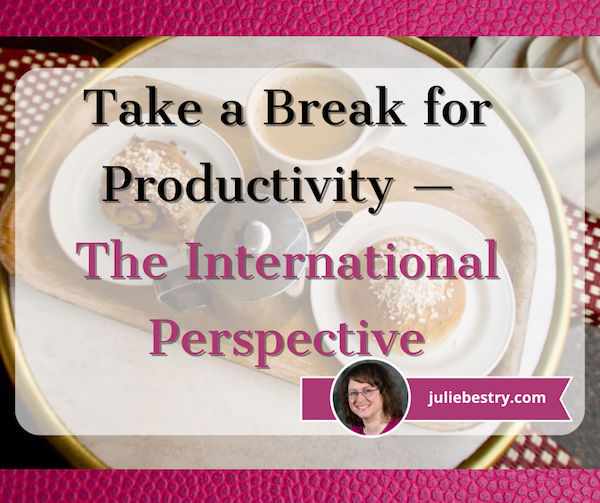
RECAPPING THE IMPORTANCE OF TAKING A BREAK
Last week, in Take a Break — How Breaks Improve Health and Productivity, we looked at the key benefits of taking breaks in helping us improve our mental and physical well-being as well as achieve our goals. These included:
- Enhanced physical health
- Reduced stress
- Increased energy and motivation
- Improved focus, memory, and concentration
- Prevention of decision fatigue
- Enhanced creativity and problem-solving
We also examined the various durations of breaks and their relative advantages for different purposes, from the teeny 20–20–20 breaks to prevent eyestrain (every 20 minutes of screen time, look away from the screen and focus on something at least 20 feet away for at least 20 seconds) to the quick breaks as we transition between meetings or tasks.
We looked extensively at the medium-length work breaks we often fail to indulge in (but need so much to refresh our bodies, brains, and spirits). Breaks benefiting the body include time taken for meals and snacks, resting and napping, walking, and even dancing, while pauses that improve mental function and emotional well-being include meditation or mindfulness, time spent in nature, and breaks for doing creative things, appreciating some aspect of life or culture, and socializing.
And, of course, breaks extend all the way to full vacations.
A SIDEBAR (SIDE TRIP?) FOR VACATIONS
Did you know that the longer a vacation is, the better it is for you, but only up to a certain duration? The average American worker is entitled to about 16 days of paid leave (combining holiday and vacation days), though we should note that about a quarter of workers get no paid leave at all!
Americans have a habit of trying glom vacation days onto long holiday weekends to try to pack month’s worth of need rest and relaxation into four days. While any break break is better than none, such short vacations fail to provide substantive recuperative benefits. Worse, according to a Pew Research Center Survey, 46% of U.S. workers who do get paid time off take less than they are allowed.
The reasons for workers shorting themselves time off vary and overlap: 52% don’t recognize the need, 49% worry that they will fall behind (and reap negative repercussions, including angering supervisors, risking their prospects for advancement (or even risking their jobs), and 43% feel guilty about their workload having to be handled by co-workers taking on additional work.
With all of these reasons not to take vacation, the counter-argument is obvious in the Harvard Business Review piece, You’re Never Going to Be “Caught Up” At work. Stop Feeling Guilty About It. Work keeps coming!
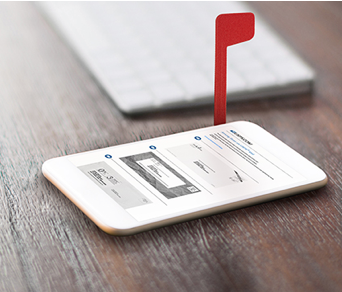 © United States Postal Service
© United States Postal Service
I always tell my clients that not only is Inbox: Zero largely a fallacy, so is Laundry Basket: Zero. Unless you decide to stop sending email or your family members all become nudists, it all keeps coming. We’re humans, not robots, and can do only so much. So, as the article says, we must practice self-compassion, focus on our accomplishments rather than our shortfalls, and use mindfulness.
Don’t guilt yourself into trying to accomplish an inhumane amount of work, and go back to last week’s post to see why you need to take breaks!
Finally, the Pew study didn’t take into account self-employed workers. We have our own reasons for not taking vacations; primarily, if we’re not working, we’re not earning, and without the predictability of a paycheck (and with the fear of clients forgetting we exist if we aren’t there to answer the phone), we’re hesitant.
But we all need vacation breaks for the same reasons we need those multiple daily breaks — to keep us physically and emotionally healthy, mentally sharp, and productive.
So how long should a vacation be?
According to a study published in the Journal of Happiness Studies, the ideal length of a vacation is approximately eight days. Researchers found that happiness levels rise over the first few days of vacation (as individuals acclimate to fewer stressful demands and the greater opportunity to sleep in those cushy hotel beds that they don’t have to make up themselves).
As physical and mental distance between work and vacation life expands, happiness peaks on the eighth day.
However, eventually the sense of well-being that comes from vacation starts to taper off, and by day eleven significantly drops. In order to get the most recuperative benefits of a vacation, researchers encourage taking multiple vacations spaced throughout the work year, ideally lasting between seven and 11 days.
A less academically stringent poll of 1000 respondents by Insider.com found that workers who took an average of 13 days off each year were satisfied and felt they took the “right amount” of time off, while those who wished they had taken more time off took an average of 10 days off. And, interestingly, people who said they took too much used an average of 14 days. (I suspect that’s where guilt starts to set in.)
Obviously, what you do with your vacation matters; you’re far more likely to be bored on day 12 of a staycation in snowy Detroit in January than on the same day of a two-week trip to Italy. Ask me how I know!
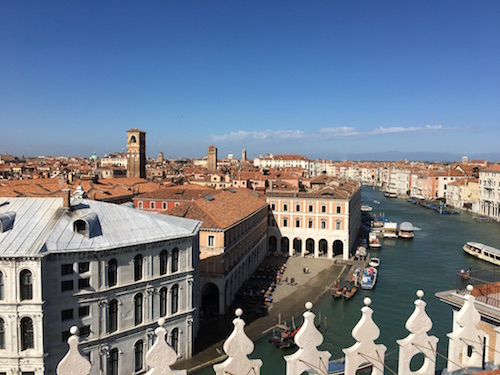
Day 12 in Venice, September 2018
Multiple 7-to-11-day vacations throughout the year? What did I say about a quarter of Americans not getting any paid leave at all? We might want to consider the health and productivity benefits of vacation trends around the world.
First, the European Union guarantees four paid weeks off annually. Beyond that:
- France — French labor law mandates a minimum of 30 working days of paid leave for employees.
- Finland — Finnish labor law also stipulates a minimum of 30 working days of paid vacation per year for employees.
- Austria — Austrian labor law guarantees a minimum of 25 working days of paid annual leave.
- Denmark — Danish labor law provides for a minimum of 25 working days of paid vacation.
- Germany — German labor law ensures a minimum of 24 working days of paid leave, which can increase based on the collective bargaining agreements and the length of service for an employee.
- Spain — Spanish labor law provides for a minimum of 22 working days of paid leave, with additional days for particular circumstances such as marriage, relocation, or special personal events.
It’s not just Europe. Brazilian labor law guarantees a minimum of 30 consecutive days of paid annual leave for workers, which can be split into three periods, one of which must be no less than 14 consecutive days! Panamanians get 30 days of paid vacation each year, on top of 10 paid holidays, while workers in India get 18 vacation days a year along with an additional 7 days of “casual leave,” totaling 25 paid (non-holiday) days each year.
But yes, Europeans in particular know how to take recuperative breaks. But what about those medium-length breaks we discussed last week, time taken out of our daily work grind, perhaps mid-morning, mid-day, or during the afternoon?
INTERNATIONAL TAKES ON BREAKS
Let’s look abroad to see what practices and rituals we might borrow, emulate, or at least appreciate from our international friends to successfully take pauses that refresh us.
Obviously acceptance (and formalization) of these practices vary by workplace and cultural context. Nonetheless, the significance lies in how these practices can promote work-life balance, foster true social connections, and/or enhance overall well-being and productivity.
BREAKS FOR REST
Siesta
Most of us are well-acquainted with the Spanish and Latin American tradition of siestas or afternoon naps, even if we’ve only learned of it from old movies or novels. A siesta is generally practiced as a nap (or at least rest) break after the mid-day meal, generally lunch.
Historically, the ritual of a siesta was practiced by rural workers to combat the effects of heat and bright sun in warm-climate regions. As the world became increasingly urbanized in the 20th century, the tradition of the siesta began to decline, to mixed results. While many workplaces have eliminated the option of time for a siesta, others have preserved the concept of a two-hour lunch break as a cultural tradition.
Indeed, those who have embraced the extended lunch (whether workers use it for sleep or just mental recovery) find that not only do employees benefit from being able to recharge and improve their work-life balance, but that workplace productivity increases for the latter part of the workday.
The value of a siesta has seen bit of a resurgence. In 2015, the mayor of the municipality of Ador, Valencia in Spain proclaimed a state-sanctioned right to an afternoon nap between 2 p.m. and 5 p.m. The edict was, in part, a way to guarantee that employers recognize that manual laborers and agricultural works could take breaks when high temperatures peaked. But the proclamation also encouraged residents to return home to nap, and requested that parents keep their children indoors and that workers refrain from making undue noise.
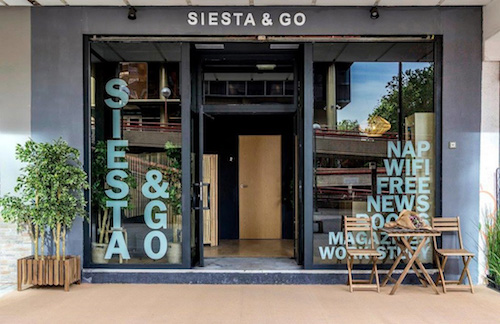
In 2017, Madrid saw the opening of Spain’s first nap bar in Azca, the Spanish capital’s financial district. Because most city workers can’t get home during the post-lunch afternoon slump, the nap bar provides private rooms (for about 14 Euro (~$14.81/hour) as well as shared rooms with bunk beds 10 Euros (~$10.58)/hour.
They also offer study nooks and cozy chairs, and if you want a shorter nap/rest time, you can book by the minute, and service includes a wake-up call!) (Germaphobes, worry not. Sheets are changed and professionally cleaned between uses.)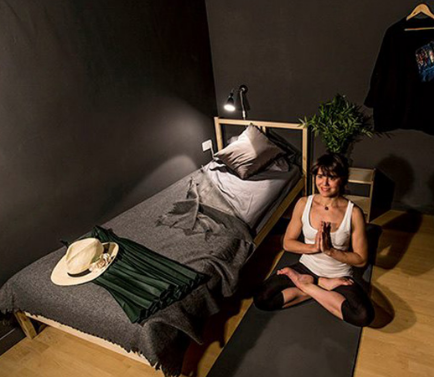
In the years since it opened, Siesta & Go has continued to expand and is now considered a hostel.
Mesimeri
In Greece, Cyprus, and many Mediterranean and Middle Eastern nations, Mesimeri refers to the midday break where businesses and offices often close for a few hours during the hottest part of the day. Mesimeri refers to the time between 2 p.m. and 5 p.m. where individuals have the opportunity to rest, relax, and enjoy a leisurely meal before resuming work later in the day.
The notion isn’t just taking a break, but that everyone is strongly encouraged to be quiet — road work and construction shuts down, and stores close. While the napping aspect of Mesimeri was practiced by almost all individuals until about 30 years ago, Greek laws still define official quiet hours where loud music and work-related noise outside are banned. It’s easy to see how these communal pauses, when everyone is allowed — even expected — to take breaks eliminates any sense of guilt about not powering through at work.
Inemuri
Culturally, it would be hard to find a productivity paradigm more at odds with Spain’s siestas, Mediterranean Mesimeri, or even France’s traditionally long lunches than Japan’s work-centric approach. In Japan, there are no formal, unified times for culturally agreed-upon rest breaks. Instead, there’s Inemuri.
Inemuri translates to “being present while sleeping,” and refers to a sort of cultural acceptance of napping in public, whether in the workplace, on public transportation, or in parks. Rather than “if you see something, say something,” in the U.S., where you might assume a dozing person is unwell, Inemuri suggests that if you see someone conked out, they are less likely to be ill or have been imbibing and more likely to be evincing signs of dedication to their employers and hard work.
Obviously, this work-til-you-drop lifestyle is not something we want to emulate, but the acceptance of Inemuri allows people to take short rest breaks throughout the day. So, at least there’s a culturally accepted practice giving workers the capacity to recharge during Japan’s excessively long work hours.
And, if you don’t feel like sleeping at your desk, there are nap cafés and even vertical nap pods available in many workplaces and cafés to grant privacy (so nobody sees you drool). For example, there’s the GiraffeNap, a TARDIS-like capsule with headrest, cushioned seat, and footrest.
If you’ve got more time to watch a TikTok influencer experience the full Janapese nap pod experience, try this:
Wu Wei
In China, the Taosist concept of Wu Wei can be translated as “non-doing” or “effortless action.” , and it emphasizes the essentiality of taking breaks in order to allowing yourself to be in harmony with the natural flow of life. Wu Wei is less of a specific break ritual, and more a way of thinking, living, and working such that society (and the work place) values time for rest and creating balance in daily activities.
For more about the power of napping and resting:
- Inemuri & Siesta — Method Behind the Madness
- Napping: Benefits and Tips
- The long-term memory benefits of a daytime nap compared with cramming
- The Pros and Cons of the Siesta
BREAKS TO EAT AND SOCIALIZE
Merienda
In Spain, Portugal, North Africa, Brazil, and The Philippines, Merienda is the practice of taking a mid-afternoon break from work or school for a light meal or snack. As you might expect, this practice is a more official opportunity granted for individuals to take a brief pause, enjoy some refreshments, and recharge before continuing with their tasks.
After all, as we discussed last week, when our blood glucose suffers, brain fog zaps our ability to learn, remember, focus, or create. A merienda meal generally consists of simple snacks (bread, fruit, yogurt) and beverages (from child-friendly milk, hot chocolate, and fruit juice to more adult-appealing coffee and even light alcoholic drinks).
In South America, particularly Uruguay, Paraguay, Argentina, and Brazil, the break is later in the day and a bit heavier, while in the Philippines, merienda culture the break for relaxation and rejuvenation comes twice a day, once in the mid-morning and again in mid-afternoon.
As long as you’re taking a break to read this post, want to make some merienda delicacies or read more about Spanish Meal Times and La Merienda — What and When to Eat?

La Merienda, or The Afternoon Meal, 1772, by Luis Meléndez, Metropolitan Museum of Art
Tea or Chai Break
Throughout the United Kingdom, places colonized by the UK over centuries, and in Asia, tea breaks for snacks (and not just the beverage tea) and socializing have been popular for the past two hundred years. The break for “a cuppa” is not merely culturally accepted, but respected, and provides the opportunity for workers and students to relax and foster social connections with their cohorts, both (as we discussed last week), improving well-being and productivity.
The equivalent of the tea break in India is the chai break, and similarly involves pausing work to enjoy a hot beverage, a snack, and some convivial conversation.
Riposo
Italy has lots of daily social rituals. La Passeggiata is a leisurely evening stroll designed to shake loose the cobwebs and stressors of the day and ease into the evening; it also gives people the chance to greet their neighbors.
Riposo is a bit of a cross between a siesta and a merienda. Many Italians practice a long riposo lunch break, closing during (varying hours) from Noon to 4 p.m. to go home (or to restaurants) and take an extended pause for lunch and quiet time. While this is less often observed these days by knowledge workers in offices, the riposo custom is still observed by stores, museums, and churches, while restaurants stay open throughout the afternoon to accommodate those not able to return home.
THE SWEDES TAKE THE CAKE FOR TAKING A BREAK
At the risk of sounding like a spokesperson for IKEA or the Swedish Tourism Board, Sweden has cornered the market on taking breaks for the betterment of everyone. They practice two break-reated concepts that are central to feelings of well-being and improved productivity.
Lillördag
Let’s start with the Nordic concept of Lillördag (pronounced lee-lur-dog), a Swedish word meaning “little Saturday.” Conceptually, it encourages breaking up the monotony of the workweek with the spirit of some weekend mojo.
Generally, Swedes practice lillördag on Wednesdays, and it often includes going out for drinks with colleagues. (When I worked in television, I found that this habit (particularly among the sales staff) was called “any day ending in a Y.” But I digress.)
Rather than being seen as a work-related obligation that might contribute to toxic productivity, lillördag generates the sense of a mini-vacaton mid-week, giving workers something to look forward to amid the drudgery of a typical workweek.
The goal is to actually combat toxic productivity, prevent burnout, and promote mental recovery. Participants are sociable, but they aren’t merely moving work-related conversations about client obligations or how annoying Carol in Accounting can be into a more convivial (or boozy) atmosphere. Rather, lillördagers (I made that up) are encouraged to avoid talking about cranky-making things and just be social.
When I first heard about lillördag, it reminded me of Laura Vanderkam’s advice in her book Tranquility by Tuesday: 9 Ways to Calm the Chaos and Make Time for What Matters about scheduling little weekly adventures!
Vanderkam found that to get out of our daily/weekly ruts, we all require more novelty, texture, and richness in our time and our tasks. Vanderkam encouraged everyone to plan life in weeks, and to identify one “big adventure” (lasting perhaps half a weekend day) and one “little adventure” (lasting an hour) each week to introduce novelty. As Vanderkam says, “We don’t ask where did the time go when we remember where the time went.”
With lillördag, the “little Saturday” break from workweek drudgery on Wednesday can enliven your spirit. But lillördag is truly little in importance when compared with Sweden’s biggest break concept: fika!
Fika
Considering that fika — a quasi mandatory (but relaxing) coffee and cake break — is so ingrained in, and important to, Swedish culture that it’s protected by law, it’s shocking that it’s not better known around the world.
The purpose of fika is not merely taking a snack break. It’s about slowing down, stepping away from work, and connecting or even bonding. Swedes do not grab a cup of coffee and a muffin from the office canteen or break room and then head back to their desks to eat.
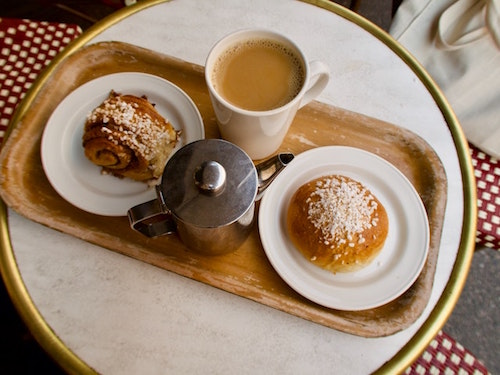
Rather, fika breaks are designed to give people an opportunity to savor — the time away, the company, and the confections. (We’ve talked before about the importance of savoring for attending, appreciating, and enhancing positive experiences in life. If we don’t step away from our work to appreciate other aspects of life, everything turns into “All work and no play makes Jack a very dull boy.”
As you might guess from last week’s post, the Swedish taking of fika breaks is positively correlated not only with enhanced physical and emotional well-being, but also improved productivity and efficiency. Decades ago, researchers found that the most workplace accidents occurred around 10 a.m. and 3 p.m., and a practice was instituted for workers to take breaks at those two times.
The name fika, used as both a noun and verb, comes from a twisting of the letters in kaffi (coffee). It’s not about the coffee and pastries, per se, though the options are mouth-watering, such as those shown in The Culinary Art of Fika.
Fika works as a pressure valve, an opportunity not only to clear one’s head for a reset and refresh, but also an opportunity to step away from work culture. It’s considered bad manners to talk about work during fika. Instead, share a photo of your dog (or your kid), discuss everyone’s recent or upcoming vacations, or just get to know someone better.
Traditionally, fika breaks are taken in the workplace. Individual employees or work teams may take turns bringing pastries like fikabröd, Swedish for fikabread, which they either make at home or purchase from local bakeries.
And it’s not just a little square of coffee cake or a doughnut from a box! Fika is a bit of a multi-course meal, with a bit of a social protocol around the order in which things are eaten. For example, some fika folks encourage eating the yummies from least fancy to most; for example, starting with a cinnamon bun, moving on to small cookies, and ending with a Princess Cake. (Don’t worry, I didn’t know what a Princess Cake was, either.)
Carbohydrate heaven! (While fika delicacies lean toward the sweet, savory options are allowed.)
Fika is such a big deal, culturally, that a popular podcast designed to introduce Sweden to the world is called A Swedish Fika.
Fika reminds me very much of a ritual we had at my dorm at Cornell. I lived in the International Living Centre, a mix of 144 international students ranging in age from 16-year-old freshman to 30something graduate students. Campus-wide, 11 p.m. was designated the time for a “primal scream,” where students all over campus would open their windows and howl at the indignit of too many exams and problem set.
The ILC, however, took a multicultural approach to letting off steam. From 11 p.m. onward, people would drop in and fade away from the main lounge for Coffee Hour. The dorm provided coffee, tea, hot chocolate, and a rotating bevy of store-bought (and occasionally homemade) desserts, and students would wander around the room, plunking down to chat with small cliques and reapportioning themselves, comfortably leaning against the fireplace, hanging over the ends of couches, and splaying themselves on the floor.
As the nighttime waned, some folks meandered off to sleep, while most returned to their rooms, the smaller study lounges, or back to campus for late night library sessions, energized from the caffeine, sugar, and social lubrication of Coffee Hour. Now I wonder if a Swedish ILC-er started the tradition!
Are you familiar with any international cultural practices for break-taking that I didn’t mention? And which of these breaks would you most like to incorporate into your work day? Would you like to fika mid-morning? Riposo or siesta in the late afternoon?






Julie, I loved reading this but….
I remember that my brother and his family lived 6 months in Luxembourg while he was overseeing a student exchange program connected with Miami University. They fell in love with the slower rhythms of the country. The evening walks often to a restaurant in the town below. The afternoon breaks. The Sundays when the stores were often closed.
When it was time to return home, they decided to keep some of these new routines. My brother said, “Well, that lasted about two weeks.”
It just didn’t transfer well into our country’s expectations and pace of living. 🙂
So true, just as eating healthily on a Mediterranean trip — lots of veggies and fresh fish instead of fried things and meat…and fast food — is harder to maintain when we get back to our real lives. It takes motivation and gumption to live in a way that’s better for us, and it’s probably hard for most people. We have to fight the status quo, and that’s tough for everyone!
Thanks for reading and sharing your brother’s story.
I believe this… “such short vacations fail to provide substantive recuperative benefits.” The short ones aren’t long enough to ever relax.
I think I’m living in the wrong country. I don’t know how all these other countries stay competitive with their employees gone all the time. Particularly Europe. But when I was discussing this with my son-in-law, he asked, “How many large/successful french companies can you name?” That got me thinking too.
I remember a woman on Oprah who vacuumed naked. She did all her housework on one day and didn’t want to have dirty laundry in her hamper after working on it all day. So funny!
I think the Swedes need all the “up” they can get. I get depressed in CT with the lack of daylight, so I can only imagine. I do think a midweek break is a terrific idea. It’s easier to power through 3 days than 5 (or 6) right?
I think we need the employers to read this and encourage their employees to take more time off. Can you just make that happen?
You make points that I wanted to talk about in the post, but (as always, it was already too long.) The funny thing is, the Nordic countries are always rated the happiest in the world, and the countries that are most productive (GDP per capita) are mostly nations with better lifestyles. #1 is Luxembourg, then Singapore, then Ireland. Norway and Switzerland are above us, too. The United States ranks 10th.
As for financial productivity, We’re bigger, but the the fact that we don’t know successful French companies probably doesn’t mean that they aren’t; their largest companies are companies that we actually know, even though we don’t know that we know them. We know their products, rather than their parent companies. Sanofi is a huge pharmaceutical company, maker of insulins and vaccines. L’Oreal is a 32 billion dollar company. Michelin makes auto parts used the world ’round. All French. Volkswagen, BASF and Aldi make cars, chemicals, and foodstuffs we use daily. Americans have a narrow knowledge of the successes of the rest of the world, so we think we’re the best.
I can’t even handle the lack of daylight in winter, and I live in the south. I need snack breaks, too! 😉
And yes, I’d like to just beat toxic companies into submission!
Great post! Very informative. We had a 12-day trip to Seattle and a cruise to Alaska this summer. It was the first long trip for all of us before COVID. It took some time to settle down and acclimate and then enjoy the rest time. I’m so glad there were things to do; I don’t think my family could have handled not having a plan. Each day, we scheduled one activity that was a few hours. This was enough for all of us to feel like we had something to do. By the 12th day, everyone wanted to come back, while I was OK with another few days. Lol, but that’s just me because I am self-employed. =)
I think your family showed that the research is on point! It sounds like you had a lovely vacation.
Thanks for reading!
Thank you for the informative article on taking breaks. It was fascinating. I take breaks in my van. I stop and have a nap in a safe spot and then carry on. I also change the pace of my week. So some days are like a break because the work is so different from the other days. I look forward to that change of pace within my work week. I have taken a lot of 8 day vacations. However, I don’t consider travel days as part of my vacation time. So in reality my vacations are 10 days. I think you are right that after being away 8 days I am done finding things to do and places to eat all the time.
You’re right that the varied pace of our client work keeps us from getting bored. Unlike typical knowledge workers, we’re not staring at a screen for 8 hours straight, and that makes a huge difference in our need to be refreshed. And I’m delighted to hear that you nap!
Thank you for reading!
Fika! They took a fika break on every episode of The Gentle Art of Swedish Death Cleaning (the 2023 Netflix show)! Although I don’t recall there being so many pastries involved. That’s a lot of pastries — and twice a day?
It was fun to read about other countries in this post and I’m reminded of the time I went to France for a month by myself in August, when everyone from Paris (well, not everyone) was on vacation elsewhere. I started out in Paris and took several side trips, including to Provence, returning to Paris around the same time as the rest of the Parisiennes (La Rentree). The weather had changed by then so it was fun to see a change of seasons in the same trip!
Thanks for triggering that memory! I never wasted a day of vacation by not taking it! And I’d often extend business trips in nice locations by adding a few vacation days. We accrued vacation according to our time in service. I think I was up to 4 weeks by the time I was laid off.
Don’t quote me, but I imagine people in Sweden probably don’t eat ALL the pastries twice a day. Maybe it’s just the coffee in the afternoon?
I knew that Europeans, and especially the French, take August off, but I think it’s cool that you got to experience the resurgence of life into Paris along with the natives!
I’ve definitely worked in places where they gave you a hard time about taking your vacation days, but it’s part of your package, along with salary and insurance; not taking it would be like refusing a paycheck! Good for you for taking all the vacation due to you! And thank you for reading!
Oh wow, Julie! What a wealth of information, terms, and videos. My brain is lighting up with all these ideas.
The one thing that stands out is how sadly, we don’t value taking real, substantial breaks in the States. As much as we talk about long weekends, vacations, and short breaks, as a country, we need more practice and better laws to support breaks.
For a variety of reasons, we typically don’t take 7-11 day vacations. We tend to do more long weekends, which are more manageable. However, for our 40th anniversary, we went away for a little over a week and it was amazing. I didn’t even recognize us by the end. Relaxed took on a whole new meaning.
I’m taking your post to heart and reconsidering our “break” patterns. Also, those stand up sleep pods are quite something. I’m not sure it would work for me. I prefer a sofa and cozy blanket. But whatever works, right?
I’m with you — ever since I started delving into all the ways our culture contributes to toxic productivity, I’ve been examining how it’s done elsewhere, and it’s fascinating. People rarely die at their desks in the US as they do in Japan (it’s shocking!) but we’re still overworking and under-resting.
I’m not sure I could sleep vertically because of my tonsils, but I do like the idea of being able to take rest breaks in any way possible to refresh the brain and body!
Thank you for reading!
I enjoyed reading your article. The vacation time for some of the country’s is amazing. As a person that was self employed I recognize the value of down time. (Vacation) I also recommend doing something special. I remember taking a vacation to Italy and going to the Ghetto in Rome. Be open to trying new things.
I have made life long friends on vacation. Taking time to get away from work, NOT checking emails, let your coworkers handle any questions/problems. When you come back refreshed you will be a better employee, and have a new attitude toward your work responsibilities.
Hello, my travel friend! I was recently reminiscing about our little group trip to the have those fried artichokes in the Ghetto in Rome! I can’t believe that was five years ago!
Breaks of all sorts give us the change to refresh, but there’s something powerful about going on vacation and making those human connections! I can’t imagine Venice without recalling skipping like a little kid across the Piazza San Marco with you, and the four of us bobbing along in the boat on the way to the airport. You’re so right — a properly taken vacation, where all work is left behind, is life altering!
Thanks so much for reading and sharing your thoughts!
Thank you for writing about different countries and their cultures. And vacations are so important to relax and regroup.
I enjoyed reading your article thanks so much.
Thank you for reading. I’ve really become fascinated by everything related to organizing and productivity in other cultures, so this was a fun one to research.